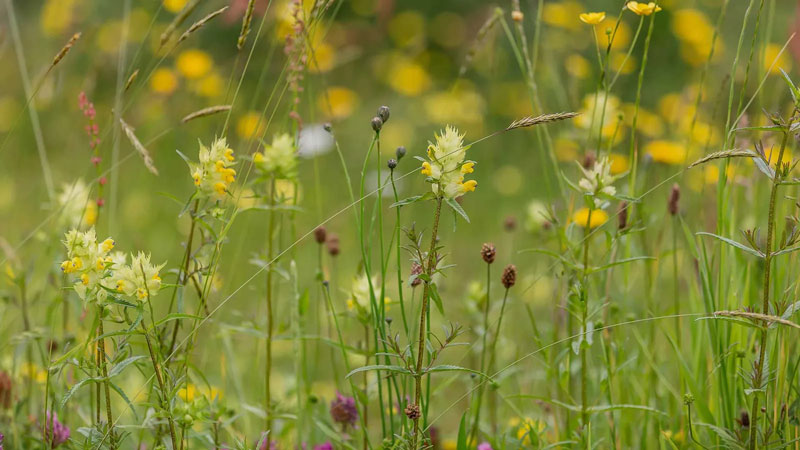
The role of Yellow Rattle in UK meadows
The Unsung Hero of Wildflower Meadows
When we think of wildflower meadows in the UK, vibrant displays of poppies, daisies, and buttercups often come to mind. However, there's one small but mighty plant that plays a pivotal role in creating these rich tapestries of colour; the Yellow Rattle (Rhinanthus minor). Often overlooked due to its understated appearance. This humble plant is actually a cornerstone in the ecological balance of meadows, earning it the nickname "meadow maker."
What is Yellow Rattle?
Yellow Rattle sometimes known as hay rattle is an annual plant that can be found across the UK, particularly in ancient meadows and grasslands. It gets its name from the yellow flowers it produces and the rattling sound made by the seeds in their pods as they mature in late summer. But what makes Yellow Rattle truly fascinating is its parasitic or hemi parasitic nature.
A Parasitic Plant with a Purpose
Unlike most plants, Yellow Rattle is a hemiparasite, meaning it derives some of its nutrients from other plants. It does this by attaching its roots to the roots of nearby plants, mainly grasses, siphoning off water and nutrients. While this might sound detrimental to the meadow, it’s a key factor in maintaining the diversity of wildflowers.
Keeping Grasses in Check
Grasses are often highly competitive and without intervention, they can easily dominate a meadow, crowding out more delicate wildflowers. Yellow Rattle, by weakening these grasses, creates space and opportunities for a wider range of species to thrive. This reduction in grass vigour leads to a more open sward, allowing wildflower seeds to germinate and grow. The result is a meadow rich in diversity, both in terms of species and structure.
Promoting Biodiversity
The introduction of Yellow Rattle to a meadow can lead to an explosion of biodiversity. With grasses no longer monopolizing the space, wildflowers such as orchids, corn cockles, vetch and others can flourish. This, in turn, attracts a variety of pollinators, including bees, butterflies, and moths; this trait has been recognised by the RHS as Yellow Rattle has been included in its plants for pollinators list for increasing biodiversity. An increase in insect life then supports a wider range of birds and small mammals. In turn, this creates a thriving ecosystem that benefits from the presence of Yellow Rattle.
The Conservation and Management of Meadows
For conservationists and land managers, Yellow Rattle is a vital tool in meadow restoration projects. By sowing Yellow Rattle seeds, they can reduce the dominance of grasses and encourage the growth of a more diverse range of wildflowers. This process we have found often takes a few years to fully establish due to the extensive ground coverage often enjoyed by grasses; but the long-term benefits are significant, leading to resilient and biodiverse habitats.
A Natural Solution to Declining Meadows
The UK's wildflower meadows have declined dramatically over the past century, with over 97% of them lost due to changes in agricultural practices and land use. The reintroduction of Yellow Rattle into these landscapes is a natural and effective way to restore these precious ecosystems. It’s a small plant with a big impact, reminding us of the delicate balance required to maintain biodiversity in our natural landscapes.
Conclusion: Celebrating the Meadow Maker
Yellow Rattle might not be the most eye-catching plant in a wildflower meadow, but its role is crucial. By curbing the dominance of grasses, it allows a greater variety of plants to thrive, enhancing the beauty and ecological value of the meadow. As conservation efforts continue across the UK, Yellow Rattle will undoubtedly remain a key player in the revival of these vital habitats.
So, next time you wander through a wildflower meadow, take a moment to appreciate the understated heroism of Yellow Rattle; the plant that makes the meadow bloom.

